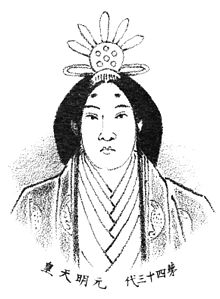Empress Genmei (元明天皇, Genmei-tennō, April 20, 660 – December 29, 721), also known as Empress Genmyō, was the 43rd monarch of Japan,[1] according to the traditional order of succession.[2] Genmei's reign spanned the years 707 through 715.[3]
| Empress Genmei 元明天皇 | |||||
|---|---|---|---|---|---|
 | |||||
| Empress of Japan | |||||
| Reign | August 18, 707 – October 3, 715 | ||||
| Predecessor | Monmu | ||||
| Successor | Genshō | ||||
| |||||
| Born | Ahe (阿閇 or 阿部) April 20, 660 | ||||
| Died | December 29, 721(721-12-29) (aged 61)[citation needed] Nara, Japan | ||||
| Burial |
Nahoyama no higashi no misasagi (奈保山東陵) (Nara)
| ||||
| Spouse | Prince Kusakabe | ||||
| Issue |
| ||||
| |||||
| House | Yamato | ||||
| Father | Emperor Tenji | ||||
| Mother | Soga no Mei-no-iratsume | ||||
In the history of Japan, Genmei was the fourth of eight women to take on the role of empress regnant. The three female monarchs before Genmei were Suiko, Kōgyoku/Saimei, and Jitō. The four women sovereigns reigning after Genmei were Genshō, Kōken/Shōtoku, Meishō, and Go-Sakuramachi.
Before her ascension to the Chrysanthemum Throne, her personal name (imina)[4] was Abe-hime.[5]
Empress Genmei was the fourth daughter of Emperor Tenji;[5] and she was a younger sister of Empress Jitō by a different mother. Her mother, Mei-no-Iratsume (also known as Soga-hime), was a daughter of Udaijin Soga-no-Kura-no-Yamada-no-Ishikawa-no-Maro (also known as Soga Yamada-no Ō-omi).[5]
Genmei became the consort (nyōgo) of Crown Prince Kusakabe no Miko, who was the son of Emperor Tenmu and Empress Jitō.[5] After the death of their son Emperor Monmu in 707, she acceded to the throne.[6] At least one account suggests that she accepted the role of empress because Emperor Monmu felt his young son, her grandson, was still too young to withstand the pressures which attend becoming emperor.[7]
After Empress Genmei transferred the seat of her government to Nara, this mountain location remained the capital throughout the succeeding seven reigns.[13] In a sense, the years of the Nara period developed into one of the more significant consequences of her comparatively short reign.
Genmei had initially planned to remain on the throne until her grandson might reach maturity. However, in 715, Genmei did abdicate in favor of Mommu's older sister who then became known as Empress Genshō. Genshō was eventually succeeded by her nephew, who then became known as Emperor Shōmu.
The Empress reigned for eight years.[6] Although there were seven other reigning empresses, their successors were most often selected from amongst the males of the paternal Imperial bloodline, which is why some conservative scholars argue that the women's reigns were temporary and that male-only succession tradition must be maintained in the 21st century.[15] Empress Genmei, who was followed on the throne by her daughter, remains the sole exception to this conventional argument.
After abdicating, she was known as Daijō-tennō; and she was only the second woman after Empress Jitō to claim this title. Genmei lived in retirement for seven years until her death at the age of 61 in December 721.[13]
The actual site of Genmei's grave is known.[1] This empress is traditionally venerated at a memorial Shinto shrine (misasagi) in Narazaka-cho, Nara City which has been designated by the Imperial Household Agency as Genmei's mausoleum. [16] The "mountain shape" misasagi was named Nahoyama-no-higashi no misasagi.[17]
The Man'yōshū includes a poem written said to be composed by Empress Genmei in 708 (Wadō 1) – and this anthology also includes a reply created by one of the ladies of her court::
Kugyō (公卿) is a collective term for the very few most powerful men attached to the court of the Emperor of Japan in pre-Meiji eras.
In general, this elite group included only three to four men at a time. These were hereditary courtiers whose experience and background would have brought them to the pinnacle of a life's career. During Genmei's reign, this apex of the Daijō-kan included:
Empress Genmei was born to Emperor Tenji and his concubine, Soga no Mei-no-iratsume, who held the rank of Hin (Beauty). She initially was named Princess Abe (阿閇皇女). She had an elder sister by the same mother: Princess Minabe.
Princess Abe married Prince Kusakabe, her eldest half-sister's son, and had issues: two daughters among which the eldest would become Empress Gensho and one son who would ascend the throne as Emperor Monmu.
The years of Genmei's reign are more specifically identified by more than one era nameornengō.[7]
| Ancestors of Empress Genmei[22] | |||||||||||||||||||||||||||||||||||||||||||||||||||||||||||||||||||||||||||||||||||||||||||||||||||||||||||||||||||||||||||||||||||||||||||||||||||||||||||||||||||||||||||||||||||||||||||||||||||||||||||||||||||||||||||||||||||||||||||||||||||||||||||||||||||||||||||||||||||||||||||||||||||||||||||||||||||||||||||||||||||||||||||||||||||||||||||||||||||||||||||||||||||||||||||||||||||||||||||||||||||||||||||||||||||||||||||||||||||||||||||||||||||||||||||||||||||
|---|---|---|---|---|---|---|---|---|---|---|---|---|---|---|---|---|---|---|---|---|---|---|---|---|---|---|---|---|---|---|---|---|---|---|---|---|---|---|---|---|---|---|---|---|---|---|---|---|---|---|---|---|---|---|---|---|---|---|---|---|---|---|---|---|---|---|---|---|---|---|---|---|---|---|---|---|---|---|---|---|---|---|---|---|---|---|---|---|---|---|---|---|---|---|---|---|---|---|---|---|---|---|---|---|---|---|---|---|---|---|---|---|---|---|---|---|---|---|---|---|---|---|---|---|---|---|---|---|---|---|---|---|---|---|---|---|---|---|---|---|---|---|---|---|---|---|---|---|---|---|---|---|---|---|---|---|---|---|---|---|---|---|---|---|---|---|---|---|---|---|---|---|---|---|---|---|---|---|---|---|---|---|---|---|---|---|---|---|---|---|---|---|---|---|---|---|---|---|---|---|---|---|---|---|---|---|---|---|---|---|---|---|---|---|---|---|---|---|---|---|---|---|---|---|---|---|---|---|---|---|---|---|---|---|---|---|---|---|---|---|---|---|---|---|---|---|---|---|---|---|---|---|---|---|---|---|---|---|---|---|---|---|---|---|---|---|---|---|---|---|---|---|---|---|---|---|---|---|---|---|---|---|---|---|---|---|---|---|---|---|---|---|---|---|---|---|---|---|---|---|---|---|---|---|---|---|---|---|---|---|---|---|---|---|---|---|---|---|---|---|---|---|---|---|---|---|---|---|---|---|---|---|---|---|---|---|---|---|---|---|---|---|---|---|---|---|---|---|---|---|---|---|---|---|---|---|---|---|---|---|---|---|---|---|---|---|---|---|---|---|---|---|---|---|---|---|---|---|---|---|---|---|---|---|---|---|---|---|---|---|---|---|---|---|---|---|---|---|---|---|---|---|---|---|---|---|---|---|---|---|---|---|---|---|---|---|---|---|---|---|---|---|---|---|---|---|---|---|---|---|---|---|---|---|---|---|---|---|---|---|---|---|---|---|---|---|---|---|---|---|---|---|---|---|---|---|---|---|---|---|---|---|---|---|---|---|---|
| |||||||||||||||||||||||||||||||||||||||||||||||||||||||||||||||||||||||||||||||||||||||||||||||||||||||||||||||||||||||||||||||||||||||||||||||||||||||||||||||||||||||||||||||||||||||||||||||||||||||||||||||||||||||||||||||||||||||||||||||||||||||||||||||||||||||||||||||||||||||||||||||||||||||||||||||||||||||||||||||||||||||||||||||||||||||||||||||||||||||||||||||||||||||||||||||||||||||||||||||||||||||||||||||||||||||||||||||||||||||||||||||||||||||||||||||||||
| Regnal titles | ||
|---|---|---|
| Preceded by | Empress of Japan: Genmei 707–715 |
Succeeded by |